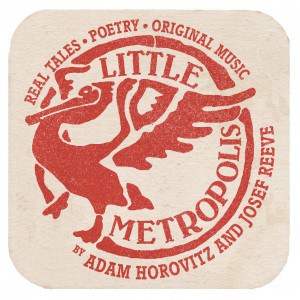Every town begins in the imagination. Every town is a continuous, sustained act of belief which exists as an entity because, collectively, we all agree that it is so. A group of people settle someplace, probably near water. They build their houses, stake their farms. Merchants come, after a while, to service them. Then come priests, then the lawyers, then bookshops, cafes, record-stores. And then, inevitably, as the old imaginations pass into the earth and new ones arise and swivel their focus off to newer, brighter loci, the town begins to fade. Towns are physical things, built by brains and calluses. Even the smallest town is layered and complex because it is the product of more than one mind. You can’t drop in on a train, spend a day wandering around the centre, and expect to know the place intimately. You have to inhabit it, become part of it. You have to add your own layer of paint, build your own wall, and watch the things you’ve added interact with all the others that arose before it. It takes a lifetime to really know a town, and it would take an ambitious imagination to attempt to distil the essence of centuries down into an hour’s worth of poetry, images, and sound so that a stranger could build a model of that town behind the ridge of their skull. Adam Horovitz and Josef Reeve have very ambitious imaginations, and Little Metropolis, their latest project, is an incredible success.
Little Metropolis is a multi-layered, multimedia project composed of local histories, poetry, original music, photography, and a series of charming illustrations that are designed to mimic the effect of existing enmeshed within the fabric of the town. The subject is Stroud, a small market town in Gloucestershire. During the Industrial Revolution it became known for its woollen mills (some of the chimneys still stand) and it remains a bustling centre whose edges are just the slightest bit faded. When you order a copy of this project you receive a beautifully presented pamphlet containing images and poetry, along with a CD composed of those same poems presented against the background of electronic music, local voices, and the cacophony of street-sounds. Taken all at once, the effect is immersive; engulfing. If you do not know what you are getting into, it can be a little much. But soon enough your disorientation passes and the reader is lovingly swept up.
It is difficult for me to effectively review the technicalities of music composition, but I can review its effect. Track nine on the CD is called ‘Ghosts’ and it deals with an odd sort of unsentimental nostalgia. In it, gentle electronica slowly morphs into passionate chaos while stanzas of poetry (focused on the slow erosion of the past) are interspersed with fragments from on-the-street interviews with locals who remember their favourite memories acquired while they were growing up. Music stores feature. So do bookstores and libraries.
The poetry ties it all together. Opening the pamphlet to page 26 you find the poem which the accompanying aural-landscape is based upon:
Ghosts wherever you tread.
Ghosts in the cinema.
In the pubs. Café ghosts. Small town ghosts.
The fallen, the crazed, the angry
and the lost. Ghosts of the dead,
of the missing-living – those friends whose paths
have turned aside from yours,
fizzing in the half-light of shift work
of altered priorities, of babies or of moving
beyond the glistening bubble of the town.
In the pamphlet, this poem is accompanied by a minimalistic line-drawing of a pair of bare feet, moving across a stark, white background, leaving a bright-red trail of blood. On the CD, Horovitz reads with a rhythmic, musical cadence against a background of city-sounds. These effects may seem contradictory; the busy soundscape, the isolated blood, but reality reflects this contradiction. In a town, one can be utterly surrounded by noise, by hustle, by crowds, and still be absolutely isolated, trapped in the white-room of memory.
Some of the poems focus on the distant past. ‘A House Built From Cloth’ describes the ways in which the industrial revolution shaped the heart and form of the town, along with the soul of the narrator:
I grew up watching the past
pulling the weight of the future
along the canal’s linear thread.
Others, like ‘Farmers’ Market’, focus on specific local places and highlight the ways in which these landscapes alter and influence the stories of the people who inhabit them:
Sad Robbie met a woman
who wore other people’s hearts on her sleeve,
reopened the conversational wounds on his tongue.
Clutterbuck stood by the donut stall
for hours, unmoving. He woke up in the Heavens,
a constellation of sugar laced across his lips.
This project is full of glimpses. Small, furtive sights that are nevertheless enough to draw you in. It would be very easy to dismiss this project as something made only for the locals of the town which it describes, but that would be a mistake. By focusing so specifically on the psychology of one individual town, Horovitz and company have opened a window into an aspect of human psychology that is universal and collective. At times, the execution might come on a little strong, but that is not a fatal flaw. This is an ambitious project, beautifully executed. I strongly recommend it.
Order your copy of Little Metropolis here: http://littlemetropolis.bandcamp.com/album/little-metropolis

